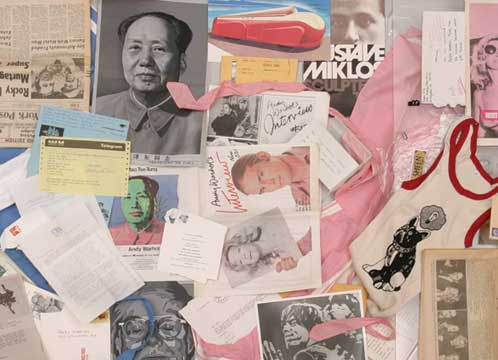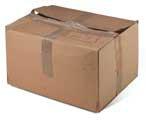 Winter 2008
Winter 2008To help keep the Time Capsules project going, contact Betsy Magley, development director at The Warhol, at magleyb@warhol.org or 412.237.8360. Several sponsorship opportunities, with corresponding benefits, are available. |
 Andy Warhol's Time Capsules
They’re mining for more Andy at The Warhol, and there’s no telling what they might unearth next—which is exactly the point. In the last year, The Andy Warhol Museum has popped the top off of some 80 additional Time Capsules—almost as many as the museum inventoried over the past 15 years. For fans and scholars of the pop art icon and his unique brand of American popular culture, that amounts to a treasure trove of fresh clues about the artist’s life and practice, with even more to come. “Since Warhol didn’t write a lot down, there’s a lot of stuff that we don’t know about him,” says Matt Wrbican, The Warhol’s archivist and caretaker of the Time Capsules. “Even his published diaries only cover the last 10 years of his life. The Time Capsules are a window into who he was, what he was doing, where he was going, and who he knew.” From 1974 until his death in 1987, Andy Warhol filled more than 610 cardboard boxes with his life’s detritus: thousands of magazines and newspapers, invitations, receipts, record albums, photographs, letters, artwork, just about anything and everything, really. Think movie ticket stubs and unpaid bills next to pizza dough and a pair of Clark Gable’s shoes, with never-before-seen pieces of Warhol’s early art tossed in for good measure. Originally, Warhol used the boxes to simplify a move from one New York studio to another. But after the move, he never stopped stashing away endless bits of ephemera—with a few priceless gems mixed in—in box after box. In 2004, Pittsburghers got a glimpse of the contents of just 18 of these Time Capsules, including a whopping 3,000 items, during an exhibition at The Warhol simply titled, Andy Warhol’s Time Capsules. And now, with three new staff members dedicated solely to the task of unpacking Andy’s boxes—thanks to a six-year grant from The Andy Warhol Foundation—it’s hard to know what other pieces of the puzzle will turn up next. Because, as Wrbican points out, what might look like a meaningless receipt, could speak volumes about Warhol’s world. This summer, within weeks of Yves Saint Laurent’s death, the team discovered a set of cards the fashion icon sent to Warhol, raving over the portrait Warhol had painted of him and complimenting his skills as an artist. Among their most attention-grabbing finds, the trio uncovered a rare diary (disguised as an exhibition catalogue)—just five or six entries’ worth—from Warhol’s time in Paris. They also found a bottle of Chloraseptic spray, a still-inflated Batman toy, a porcelain doll and a tin of meringues sent to Warhol by an adoring fan, and a prized handful of the artist’s drawings from the 1950s along with work from his time as a student at what’s now Carnegie Mellon University. It’s this kind of digging that’s priceless to those studying the work and times of Warhol, including The Andy Warhol Foundation, which for 15 years has been toiling on a multi-volume catalogue of all of Warhol’s paintings, sculptures, and drawings. Like the team at The Warhol, the Foundation fully appreciates that the Time Capsules contain buried treasure. But the cost of cracking open each Time Capsule is roughly $5,000. This includes first identifying and arranging each object by type, providing discrete numbers, scanning each and every object (keeping in mind there’s about 200 items per box), and then properly re-housing each item in acid-free folders and protective Mylar sleeves. Once that’s complete, the more detailed work begins. The end goal is providing not only a detailed physical description of each item but information about where it came from, what its purpose was, and, hopefully, its role in Warhol’s life so that, eventually, it can all be electronically tracked in a web-based database. “Once we have a web-interface, this information will be used by thousands and thousands of people around the world,” says Wrbican. “We already loan Time Capsules for exhibitions all around the world. And because of them, we all know a lot more about Warhol’s life than we would otherwise. And that’s only with fewer than half the boxes opened.” |
Darwin’s Big Bang: 150 Years Later · Paging Doctor Darwin · The Horse · 1958 · Director's Note · NewsWorthy · Now Showing · Face Time: Eric C. Shiner · Artistic License: Inside a Fantastical Mind · About Town: A Wild Weather Adventure · Science & Nature: All Hail the Telescope · First Person: Experiencing Life on Mars, Together
 |
Copyright © 2017 CARNEGIE Magazine. All rights reserved. |

 By Julie Hannon
By Julie Hannon